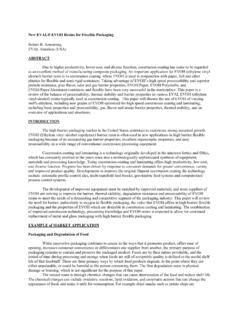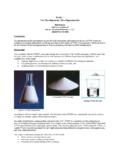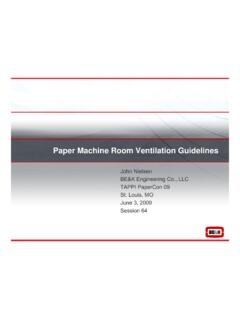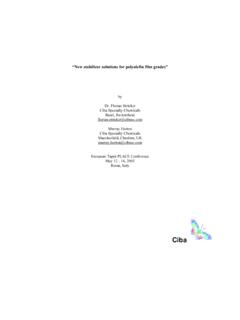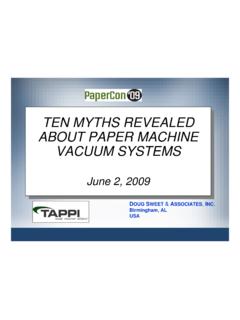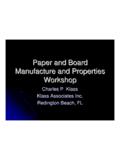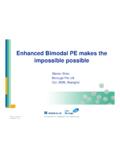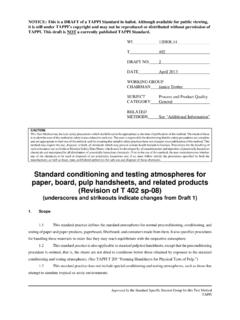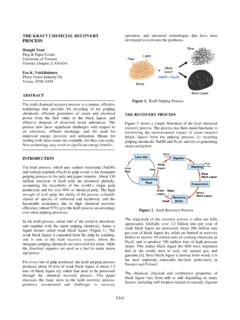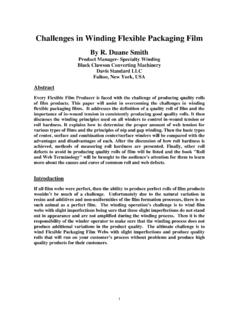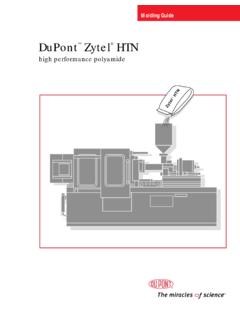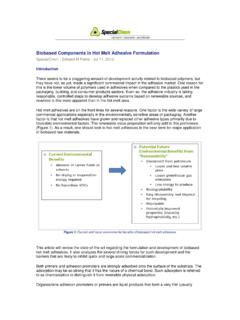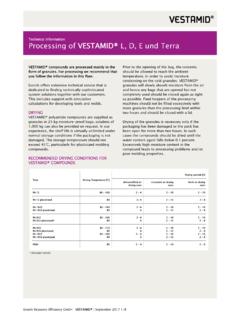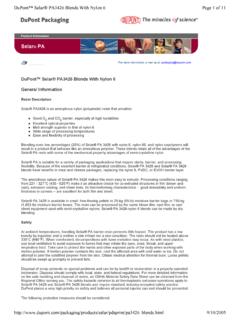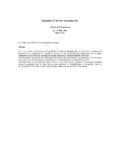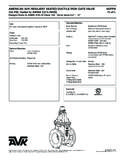Transcription of A Technology Decision – Adhesive Lamination or Extrusion ...
1 A Technology Decision Adhesive Lamination or Extrusion Coating/ Lamination ? Rory Wolf, Enercon Industries Corporation Abstract Extrusion -based coating/laminating and Adhesive -based film laminating are different manufacturing techniques a converter can use to make a composite construction. The physical properties and performance characteristics of flexible packaging made by Extrusion coating and laminating can be identical to that made by film laminating. Many of the major components of the final constructions are also the same. So which technique should be used for a particular product package? The Decision is not an easy one, with equipment availability, run length, polymer specifications, and manufacturing efficiencies some of the major variables in this equation. Introduction The performance properties of extruded and Adhesive -laminated structures are frequently dependent upon the types of polymeric, Adhesive and surface treatment/priming ingredients combined to deliver the intended package performance.
2 Multiple performance criteria such as mechanical properties, gas and moisture barrier properties, sealability, printability and cost will be integrated to satisfy the multiple performance properties of both rigid and flexible packages. Many polymeric materials are thermodynamically incompatible due to differences in their chemical make-up. Combining these materials can create the potential for phase separation and structural degradation. The key is to create a heterogeneous layering within an Extrusion or Adhesive Lamination process so performance properties will not degrade over time. Adhesive laminates can be made by dry bonding, wet bonding, UV/EB curing and by hot melt adhesion processes. Extrusion laminates are constructed by extruding a thin tie-layer of a plastic material to bond together two dissimilar materials, such as a polymer film, paper or foil.
3 Furthermore, coextruded materials are produced by extruding several polymer layers simultaneously and then pressing/cooling them together. Incompatible layers are laminated together using a thermoplastic Adhesive as a tie layer. Eight layers or greater can be produced to optimize barrier, material thickness, weight and cost performance parameters. Surface modification techniques can also be employed to for low polarity polymeric films and other based substrates to improve structural performance. These methods can include the application of roll coatings (polymers, lacquers, primers), coextrusion, immersion, and plasma treatments. Solvent and water-based barrier coatings are common, as are dry coatings such as varnishes cured by heat or oxidation. Chemical surface treatments, vacuum plasma depositions, and specifically vapor-deposited oxides and nitrides are also employed to improve packaging performance.
4 Table 1 below details a comparison of mainstream Lamination and coating processes. In the end, it Advantages Disadvantages Hot Roll Lamination 9 Ability to apply a wide variety of films 9 Medium speeds 9 Low capital costs 9 Printing distortions possible during Lamination 9 Low energy consumption 9 Ability to apply thin skins 9 Superior graphics 9 Simple Technology Extrusion Coating 9 Inexpensive raw material 9 Poor gauge control 9 Improves structure stability 9 High capital costs 9 Ability to apply thin skins 9 Little flexibility in coating type 9 High energy consumption Adhesive Lamination 9 High speeds 9 High capital costs 9 Ability to apply a wide variety of films 9 Medium energy consumption Table 1 Comparison of Lamination and Coating Systems is consumer demand for package features such as easy open packages, barrier properties, safety, tamper resistance, product efficacy.
5 Cost and manufacturing efficiencies which will directly determine which process will serve these interests. Fortunately, advances in resin Technology , new chemistry options for coatings, and improvements in surface modification and sealing methods will enable new, high performance structures to better meet these challenges. Adhesive Lamination Wet & Dry Processes The manufacture of film laminates is a continuous process of coating and bonding, with process differentiation defined by the type of Adhesive used and how the Adhesive is applied and converted. These processes are classified as either wet or dry laminating processes and are described in Table 2. Process Description Application Equipment Typical Adhesives Dry Bond Laminating Liquid Adhesive coated on substrate, dried with heat/air flow, and laminated to a second substrate via heated compression nip.
6 Gravure application cylinder Polyurethane dispersions, acrylic, emulsions, acrylic solvent, water-based polyvinyl alcohol, ethylene vinyl acetate copolymers, high solids silicone solvent Hot Melt Seal Coating Low viscosity hot melt adhesives are applied to substrate Heated rotogravure cylinder, extruder Ethylene vinyl acetate, modified polyolefins, polyesters Dry Processes Cold Seal Liquid Adhesive applied, dried with heat/air, and bonded with slight pressure so tack to non-cold seal surfaces is minimized Gravure application cylinder Synthetic rubber, acrylic / natural rubber Wet Bond Laminating Liquid Adhesive applied to substrate, then immediately laminated to a second substrate via nip, followed by drying with heat/air flow (one substrate must be porous to allow evaporation of water or solvent) Gravure cylinder or smooth roll Polyurethane dispersions, acrylic, emulsions, water-based polyvinyl alcohol, ethylene vinyl acetate copolymers, polyesters, starch, dextrin, latex, etc.
7 Wet Processes Solventless Laminating Adhesive is metered onto substrata in liquid form, then mated to a second substrate via heated nip Multiple application roll configurations Polyurethanes (on- or two-component, with ester or ketone solvent, or 100% solids), polyesters Table 2 Adhesive Lamination Processes 9 Ability to apply thin skins 9 Requires Adhesive to bond films 9 Excellent print registration Figure 1. Typical Wet and Dry Lamination Process Configurations There are a variety of process applications which dictate the level of Adhesive coating thickness immediately following surface pretreatment by either a corona, flame or plasma discharge. Table 3 shows a summary of some of the capabilities and limitations of common Adhesive coating methods that are used in producing laminates. For example, gravure-based Adhesive coating has a required viscosity of 15-1500 cps for delivering a solution or emulsion based coating weight range of 2-50 gm/m2 at a coating speed between 100-700 mpm.
8 UV or E-beam technologies, and chemical crosslinking agents formulated within the Adhesive , are then introduced to the surface Wet Lamination Dry Lamination treatertreatertreatertreaterCoating Method Viscosity (cps) Coating Weight (gm/m2) Coating Accuracy (+/-%) Coating Speed (mpm) Adhesives Commonly used Wire Rod 100-1,000 15-1,000 10 100-200 Solution, emulsion Knife over Roll 4,000-50,000 25-750 10 100-150 Solution, emulsion, 100% solids Reverse Roll 300-50,000 25-250 5 100-400 Solution, emulsion Gravure 15-1500 2-50 2 100-700 Solution, emulsion Extrusion Die 400-500,000 15-750 5 300-700 Emulsion, hot-melt, 100% solids Slot Die 400-200,000 20-700 2 100-300 Emulsion, hot-melt, 100% solids Curtain 50,000-125.
9 000 20-500 2 100-500 Emulsion, hot-melt Table 3. Adhesive Coating Method Parameters1 to initiate immediate tack and bond strength. Adhesive Lamination is a preferred method of joining substrates when a film cannot by effectively processed through a coextrusion process because of equipment limitations, because of the potential for thermal damage by coextrusion, or when the use of adhesives will benefit the final construction. Therefore, it is primarily the physical and chemical properties of the substrate which will determine the type of Adhesive and coating method which can be applied (sensitivities to water or solvent carrier, or to thermal drying), or whether Adhesive Lamination as a process can indeed be utilized. Another key process variable is surface preparation along with Adhesive selection.
10 To ensure that Adhesive will effectively wet-out and bond to the substrate, the Adhesive must have a surface tension that is approximately 10mN/m lower than the surface tension of the substrate being coated. Typical pretreatment processes include corona and flame discharge, with high-density atmospheric plasma becoming an increasingly integrated surface treatment Technology that is ideally suited for continuous polymer film Lamination because of its introduction of chemical functionality for improved bond performance. Solventless Lamination Solventless laminating is the process of metering a low viscosity Adhesive onto a multiple application roll configuration that applies the Adhesive to a first substrate, which is then mated to a second substrate via a heated nip. Single component first generation adhesives were primarily moisture-cured polyurethanes.
